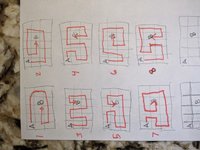Argile1845
New member
- Joined
- Feb 19, 2021
- Messages
- 32
How would I go about solving this one?
A counter is initially at square a in the grid below. It is then moved from one square to an adjacent square (horizontally or vertically not diagonally) until it ends up at square B, passing through every square in the grid exactly once. How many different paths could the counter have taken?
A counter is initially at square a in the grid below. It is then moved from one square to an adjacent square (horizontally or vertically not diagonally) until it ends up at square B, passing through every square in the grid exactly once. How many different paths could the counter have taken?





